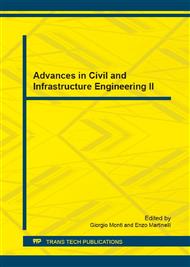[1]
Euroslag and Eurofer, Position Paper on the Status of Ferrous Slag, European Slag Association, European Steel Association, 2012, Duisburg, Germany.
Google Scholar
[2]
C. Pellegrino, V. Gaddo, Mechanical and durability characteristics of concrete containing EAF slag as aggregate, Cement and Concrete Composites, Vol. 31, No. 9, 2009, pp.663-671.
DOI: 10.1016/j.cemconcomp.2009.05.006
Google Scholar
[3]
J.M. Manso, J.J. Gonzalez, J.A. Polanco, Electric Arc Furnace Slag in Concrete, Journal of Materials in Civil Engineering Vol. 16, No. 6, 2004, pp.639-645.
DOI: 10.1061/(asce)0899-1561(2004)16:6(639)
Google Scholar
[4]
C. Pellegrino, P. Cavagnis, F. Faleschini, K. Brunelli, Properties of concretes with black/oxidizing electric arc furnace slag aggregate, Cement and Concrete Composites, Vol. 37, No. 1, 2013, pp.232-240.
DOI: 10.1016/j.cemconcomp.2012.09.001
Google Scholar
[5]
K.S. Al-Jabri, A.H. Al-Saidy, R. Taha, Effect of copper slag as a fine aggregate on the properties of cement mortars and concrete, Construction and Building Materials, Vol. 25, No. 2, 2011, pp.933-938.
DOI: 10.1016/j.conbuildmat.2010.06.090
Google Scholar
[6]
C. Pellegrino, F. Faleschini, Experimental Behavior of Reinforced Concrete Beams with Electric Arc Furnace Slag as Recycled Aggregate, ACI Materials Journal, Vol. 110, No. 2, 2013, pp.197-206.
DOI: 10.14359/51685534
Google Scholar
[7]
T.Y. Tu, Y.Y. Chen, C.L. Hwang, Properties of HPC with recycled aggregates, Cement and Concrete Research, Vol. 36, No. 5, 2006, pp.943-950.
DOI: 10.1016/j.cemconres.2005.11.022
Google Scholar
[8]
A. Gonzalez, M. Etxeberria, Experimental analysis of properties of high performance recycled aggregate concrete, Construction and Building Materials, Vol. 52, 2014, pp.227-235.
DOI: 10.1016/j.conbuildmat.2013.11.054
Google Scholar
[9]
K.H. Younis, K. Pilakoutas, Strength prediction model and methods for improving recycled aggregate concrete, Construction and Building Materials, Vol. 49, 2013, pp.688-701.
DOI: 10.1016/j.conbuildmat.2013.09.003
Google Scholar
[10]
C.S. Poon, Z.H. Shui, L. Lam, Effect of microstructure of ITZ on compressive strength of concrete prepared with recycled aggregates, Construction and Building Materials, Vol. 18, No. 6, 2004, pp.461-468.
DOI: 10.1016/j.conbuildmat.2004.03.005
Google Scholar
[11]
F. Faleschini, P. De Marzi, C. Pellegrino, Recycled concrete containing EAF slag: environmental assessment through LCA, European Journal of Civil and Environmental Engineering, Vol. 18, No. 9, 2014, pp.1009-1024.
DOI: 10.1080/19648189.2014.922505
Google Scholar
[12]
US-EPA, AP-42 Compilation of Air Pollutant Emission Factors, U.S. Environmental Protection Agency, (1995).
Google Scholar
[13]
UK NAEI, Vehicle speed emission factors. National Atmospheric Emissions Inventory, 2003, UK.
Google Scholar
[14]
NPI, Emission Estimation Technique Manual for Mining and Processing of Non-Metallic Minerals, Version 2. 0, National Pollutant Inventory, 2000, Australia.
Google Scholar
[15]
P. Van de Heede, N. De Belie, Environmental impact and life cycle assessment (LCA) of traditional and green, concretes: Literature review and theoretical calculations, Cement and Concrete Composites, Vol. 34, No. 4, 2012, pp.431-442.
DOI: 10.1016/j.cemconcomp.2012.01.004
Google Scholar
[16]
A. Josa, A. Aguado, A. Cardim, E. Byars, Comparative analysis of the life cycle impact assessment of available cement inventories in the EU, Cement and Concrete Research, Vol. 37, No. 5, 2007, pp.781-788.
DOI: 10.1016/j.cemconres.2007.02.004
Google Scholar


